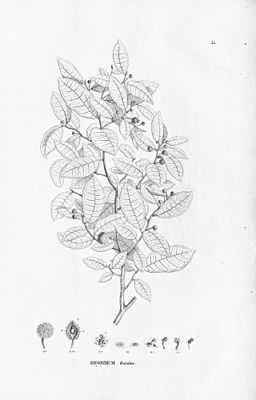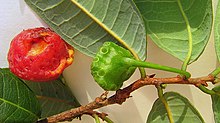Brosimum guianense
| Brosimum guianense | ||||||||||||
|---|---|---|---|---|---|---|---|---|---|---|---|---|

Snakewood ( Brosimum guianense ), illustration. |
||||||||||||
| Systematics | ||||||||||||
|
||||||||||||
| Scientific name | ||||||||||||
| Brosimum guianense | ||||||||||||
| ( Aubl. ) Huber ex Ducke |
Brosimum guianense ( Syn .: Brosimum tessmannii Mildbr., Piratinera guianensis Aubl.), German often also snakewood or letter wood tree , is a South American tree species that belongs to the mulberry family(Moraceae). Their wood is characterized by its special structure and extreme hardness and is used, for example, in musical instrument making.
Occurrence
The distribution area of the snakewood extends from Eastern Brazil ( Rio de Janeiro ) over Central America to Mexico . The main deposits are in Suriname and Guyana , among others . The main port of export is Paramaribo in Suriname.
description
In Brosimum guianense is an evergreen deciduous tree , the stature heights up to 45 m achieved by. The dark brown bark is relatively smooth and easily cracked. It has yellowish to white milky juice .
The alternate leaves are elliptical to lanceolate or obovate and have entire margins, leathery and shiny on the top. They are usually 4 to 13 cm long and 2 to 6 cm wide, but overall very variable in size and shape. At the top they are pointed to pointed, tail or rounded to indented or outlined. Characteristic features are papillae on the underside of leaves. The nerve is pinnate, often changing, and the lateral arteries converge intralmarginally. There are two stipules that have not grown together .
The trees are monoecious mixed-sex ( monoecious ). The axillary or branch-like, usually singly or in pairs appearing inflorescences are small, with up to 12-14 mm diameter, they are disc-shaped to hemispherical with numerous male flowers with only one stamen , which usually surround one or a few female flowers. The flowers are each without a flower cover . The in bloom soil sunk ovary is inferior with long stylus with zweiästiger scar . There are greenish and salver-shaped bracts that surround the male flowers.
The fleshy, drupe-like berries ( false fruits ) , up to 1.5–2 centimeters in size, turn yellow or red when ripe, the roundish, brownish seed is approximately 1–1.5 cm long.
Systematics
The first description of the Basionyms Piratinera guianensis was in 1775 by Jean Baptiste Christophe Fusée Aublet in Histoire des Plantes de la Guiane Françoise 2: 888-889, t. 340, f. 1. The division into the genus Brosimum took place in 1909 by Jakob E. Huber in Boletim do Museu Goeldi (Museu Paraense) Hist. Nat. Ethnogr. 5 (B, IX): 337, but without sufficient information. This and the confirmation took place in 1910 (1913) by Adolpho Ducke in Bol. Mus. Goeldi Hist. Nat. Ethnogr. 7: 172.
Numerous synonyms are known, such as. B. Brosimum aubletii Poepp. & Endl. u. v. a.
use
The wood supplied by Brosimum guianense is fine-pored, red-brown and characterized by blackish, radial stripes, which give it a snake-skin-like appearance. Because of this grain , which is also reminiscent of illegible letters , it is also referred to in English as letterwood ("letter wood"). Snakewood is one of the hardest, most abrasion-resistant (its density is 1.05 to 1.25 g / cm³) and at the same time one of the most expensive woods on the world market. It is mainly used for special woodturning work such as umbrella and stick handles, billiard cues or buttons, as well as in musical instrument making, especially bows for string instruments.
Trade name for the timber are snakewood , glamor , letter or letters wood , leopard wood , nutmeg wood or Amourette . The Dutch called it nutmeg because it looks like a cut nutmeg .
Others
The representatives of the genus Brosimum also include other useful plants, such as the breadnut tree ( Brosimum alicastrum ).
literature
- Harri Lorenzi: Árvores Brasileiras. Vol. 2, Instituto Plantarum, 1998, ISBN 85-86714-07-0 , p. 237, online at StuDocu.
- J. Lanjouw, AL Stoffers (Ed.): Flora of Suriname. Vol. V, Part 1, Brill, Leiden 1975, pp. 192 f, 197 ff.
Web links
- Brosimum guianense at Useful Tropical Plants.
- Brosimum guianense at Tropicos.org. Missouri Botanical Garden, St. Louis, entry in the Flora de Nicaragua (Spanish).
- Entry at GRIN
- Images (leaf, flower, fruit) from CTFS-Panama, Smithsonian Tropical Research Institute.
- Pictures of the wood, information on wood properties on espen.de.
- Details on the wood structure at the Department of Biology: University of Hamburg.
Individual evidence
- ↑ online at biodiversitylibrary.org.
- ↑ online at biodiversitylibrary.org.
- ^ Brosimum guianense at KEW Science.
- ^ The Plant List


